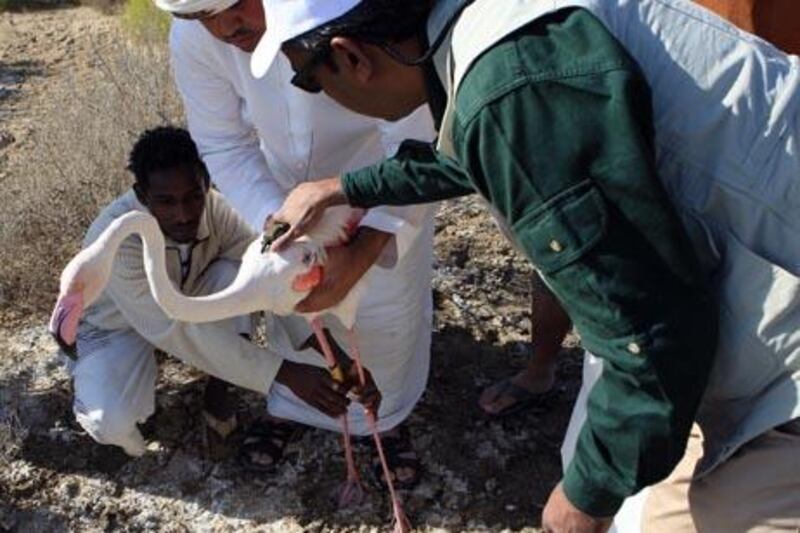ABU DHABI // Whether it decides to summer in Kazakhstan or spend its winter months in Umm al Qaiwain, this travelling flamingo will not be taking its backpack off any time soon.
The straps of a satellite transmitting backpack were tucked under another set of pink wings at the Al Wathba Wetland Reserve yesterday. It was the 15th bird fitted for the device by the Environment Agency - Abu Dhabi (EAD) to closely monitor migratory patterns and stopover spots that span thousands of kilometres.
The agency has been tracking the birds' movements in the Arabian Peninsula since 2005, and has expanded its programme to cover migratory birds of prey, including the osprey and sooty falcon.
Dr Salim Javed, the head of the EAD's bird programme, waited patiently from the early hours of the morning as flamingos splashed into the wetland waters, breaking up the reflection of nearby highway lights. He watched closely as they swam near staked leg-noose traps hidden beneath the water's surface, meant to catch the flamingos off-guard as they fed on brine.
The first bird he caught was too young; its colouring gave it away. "It is not yet mature enough to make a long journey," Dr Javed said. "As they get older their feathers, their beaks, their legs get pink."
Once an adult was caught in the trap, Dr Javed's team brought it to a site on the shore, where they weighed its lanky body and measured its 42cm wingspan before fitting it with a solar-powered global positioning system.
The 45-gram device, which sits strapped to the bird's body like a backpack, will help local and regional authorities track the bird's travels and where it will rest. The tracking of other flamingos has helped EAD to map out a migratory route between the UAE, a popular summer destination for the birds, and areas as far north as Kazakhstan. Shahama and Bul Syayeef in Abu Dhabi are also populated with flamingos, which travel up the coast to Ras al Khor in Dubai and Khor al Beidah in Umm al Qaiwain before continuing their journey to Maharlu and other areas in Iran. The birds later settle for a while at the border between Turkmenistan and Iran, and eventually continue on to Kazakhstan. They then make the trek back. Some get somewhat sidetracked, finding their way over to the western side of the Caspian Sea to rest in Azerbaijan.
"It is fascinating to see how they spend time in certain places, which helps us to discover breeding colonies," Dr Javed said, adding that the data will add to evidence that certain sites, including Al Wathba, need to be preserved.
About 2,500 flamingos live at Al Wathba, which was declared a protected area in 1999 by the country's late president, Sheikh Zayed. The area is home to more than 230 species of birds, including the black-winged stilt and the kentish plover.
Dr Javed acknowledged there is a chance that the individual flamingo caught may be a resting bird and stay in Abu Dhabi, as many do. There is no way to tell, he said.
Before releasing the bird, Dr Javed ruffled and trimmed the feathers around the backpack's straps so that it seemed to fit comfortably. He also secured a yellow tag to its leg.
Eager to escape, the flamingo stumbled out of its capturer's arms and towards the shoreline, then skipped along the water's surface with its wings outstretched before plopping in. It bobbed in the water and twisted its long neck every few minutes to look back and perhaps judge, unwittingly, whether it had fallen off of everyone's radar.





